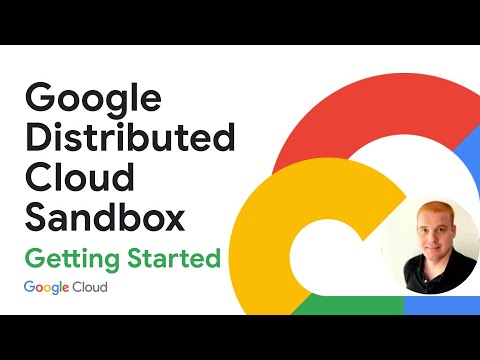Google Distributed Cloud Sandbox - Getting Started

hi team I'm TJ bassic and I'm the product manager for Google distributed Cloud sandbox today's presentation is on getting started for the agenda we'll roll through the introduction for covering what is Google distributed Cloud touch on GDC sandbox and how it fits in that equation we'll then get started with the product as far as initial access and unboxing we'll work our way into a common set of critical user Journeys including managing identity and access creating virtual machines container workloads monitoring metrics and logs for performance managing databases and storage and finally positioning you as an end user to deploy a generative AI application Google distributed Cloud provides an industry-leading solution that provides Cloud infrastructure and services that run in your data centers and Edge locations we have options for fully air gapped as well as Ed we include fully managed integrated set of services and Suites including Hardware software and open components we have flexible operations models that can be operated by any partner or Google in single and multi-site models we start small and scale to hundreds of racks GDC sandbox is a cloud-based offering and a managed emulator of the Google distributed cloud airga and Appliance experience the GDC experience is offering a coste effective and accelerated generative AI development platform for Solutions like Gemini it's coste effective because it allows you to learn and experiment before making your Google distributed Cloud investments in physical systems it increases your speed to Value removing the need to worry about the provisioning configuration and management it also provides ease of use with a familiar interface via a Pi CLI and UI of the GDC experience the product vision of GDC sandbox is grounded in six user Persona tenants the first and foremost is generative AI development this provides a cost-effective platform for developing and testing your generative AI models on the commercial or low side of the internet minimizing the risk of exposing sensitive data allowing you to build and deploy cicd pipelines into your production environments it's an onboarding enabler so if you are a new GDC customer or partner it is allowing you to get your hands on the experience I like to use the car dealership metaphor when describing this I'm not going to go into a car dealership and purchase it based on a brochure for that car I want to have a look at it I want to open the doors I want to walk around I want to take it for a test drive and ensure that it meets my needs that's really what GDC sand box does for you within the GDC portfolio it allows you to demonstrate uh the applications that you build uh to your organization to your department to your end customers it allows you to do a proof of concept so if you want that test drive to deploy your own applications ensure that they meet your requirements before you um work your way into our partner portfolio or customer Suite you do that training lab uh GDC sandbox is the first time that you'll see the GDC product in demonstrations in any training that you attend you will be doing your virtual exercises and Labs on GBC sandbox and the first time you put your hands to keyboard on our products uh very much more likely so that you'll be in GDC sandbox lastly we enable our partner portfolio uh Partners often don't invest in GDC airgap physical systems uh as much as uh application development service integration Consulting training development and GC sandbox provides an outstanding playground for those Pursuits the offering includes a basic and an AI optimized skew depending on your preference the basic skew provides the developer experience of Google distributed cloud in our airgap and Appliance offerings it includes the command line interface the user interface as well as the apis you also have all the core Services of GDC airgap to include virtual machines kubernetes containers observability object and persistent block storage and database servicing such as postgress SQL our AI optimized skew uses the basic skew and builds upon it with Gemini apis which are enabled via Google AI Studio account as well as the vertex AI apis so artificial intelligence enabling speech to text optical character recognition translation as well as for on board gpus uh which are dedicated the specifications for the user space as far as your usable resources with the emulator are detailed on the top right limitations uh these are to the emulator only and not the GDC larger product portfolio within the emulator we are emulating the product within a small scale one organization two user clusters 25 users recommended as a soft limit for mainly usage of resources it's non-persistent it lives for 30 days before being refreshed we highly encourage a station with a source code repository that's really building up your cicd pipeline stories as you rapidly are deploying applications the environment is more of a cattle than a pet it's rebuilt every 30 days with the latest updates and it's blown away and redeployed and so what that ensures is you aren't using any sensitive data or production data that you're continually rebuilding that environment as an emulator and really as a playground this is the product architecture in a broad stroke to access GDC sandbox you start on your local machine you install the g-cloud command line fire off a command that accesses the environment via RDP uh you open up your client and you land on what we call the Gateway experience there in the middle this is a Linux user machine that is your surface area behind the scenes and under the covers is the emulation so we run this on 18 fully dedicated Google Cloud GC VMS if you subscribe to the AI optimized model you also have an attachment for your GPU based capability now we're going to work our way through the use case Journey we start with getting started and what you'll see in the structure of this presentation is all of the processes that we're going to go through are going to be documented on the left as far as our product pages an overview of our documentation any caution points that are sign posted with the exclamation and our demos which is the structure of the video that you see autop plan in the top right and so for getting started we recommend that you go to our product page to start your journey you'll see that the link below is at the bottom of the screen in case you do need that for Access we encourage you to read through the product overview and documentation to understand all the ins and outs and and niches of that product the release notes show everything that we put in every version we are rolling new versions monthly and so you'll see a lot of best and brief features coming uh if you have interest we'd love to meet with your team and review our road map in more detail and really hear more about your needs and what we can do to make GDC sandbox better for your requirements the demonstration uh here is an overview of the product and so you'll notice that our YouTube presentation on the product is up in the top right definitely encourage you to go there that's a 15minute overview of the product uh very good for for shing with your stakeholders understand what the product is and and how you can use it next we'll touch on starting the instance and so the prerequisite for this is you've onboarded to GDC sandbox you've provided your Google account in your Google group during the Contracting procedures you start the instance and install the GD Cloud command line interface as you see rolling on the top right you access your documentation we do have recommended prerequisite training so if you are new to kubernetes check out our learn kubernetes with Google uh it's a very well-rounded introduction into you using kubernetes which is the foundation of Google distributed Cloud so definitely very important in your journey so next let's go into the demonstration and so in this demo uh that you just saw we're going to touch on starting the instance running the GD Cloud command line interface and accessing the GDC inbox UI e next we'll move into the signin user Journey so here we first set up and so we access the documentation for sign in and setting up the platform administrator account uh we touch on the homepage so one of the pro tips is to add our UI to the browser so anytime you access your your gateway VM it'll automatically refresh with your UI or if you have developer preferences on accessing other parts of the product uh grafana for observability Harbor for image repository uh you have the ability to set your preference there next we go into creating projects and so steps are creating a project adding your access onto that project and adding more users and so in our demo scenario we touch on sign in setting up the platform admin account creating the project let's go into the walkthrough for more details the next user journey is managing identity and act access and so we'll start with our identity provider we call it fake oidc provider and so we don't join to production systems uh by default because this is an emulator environment and so fake oidc basically provides your Landing point to uh pick and select the users that you've created and uh walk through their access procedures in the documentation reads you want to review accessing the admin cluster reviewing the cluster architecture and understanding the roles and permissions for recommended training uh we do again recommend that you look at kubernetes Essentials by Google into the IMM uh portions of that training which will be very helpful in wrapping your head around how kubernetes identity and access management works for the demo scenario that we're walking through here in the video we're looking at creating a user account uh creating roles and creating the RO bindings let's go ahead and jump into the walkthr e e e [Music] the next user journey is creating virtual machines we'll start with deploying a VM workload in our documentation that's seated under create and start of VM we'll review the documentation for that not only the deployment but also the documentation for what that tails and so for tips we have the ability to create this from a command line interface from an API or from the user interface so if you're interested in looking at more of the vehicles to interact with our product uh definitely dive into those areas and tips and so for the demo we're going to create a virtual machine uh let's jump into the walkthr e e next we'll review the user Journey for container workloads in GDC sandbox the Clusters are created for you to control the size of the emulator and the usage of it so uh Pro tip don't add or remove the dedicated clusters that you have if you're operating within the basic skew you'll see two of them if you're operating within the AI optimized skew you'll see a third for the GPU uh user journey in the documentation do review the deploy a container application as as well as creating the harbor registry to where you'll store your images uh for the container operations prerequisite training we recommend you look at the application developer guide for interacting with kubernetes and hosting container-based workloads in our demo scenario we're going to walk through importing a container and then creating a hard Harbor registry so you can host that for your kubernetes applications let's jump into the walkthrough e e e the next user journey is monitoring metrics and logs in GDC we do this on grafana which provides the aggregation of the GDC logs and metrics platform so our documentation is far and wide for this a lot of areas that you should review because really logging in metrics is really at your interest needs and requirements and so you want to review monitoring the log metrics uh collection of them the query and view how to collect operational logs that are query them and also creating alerting and monitoring rules and so in our demo we're going to review accessing grafana from the UI on our Gateway virtual machine and we're also going to look at viewing the logs and metrics let's jump into the user journey and the walkth through e e e e e we've landed on the call to act ction the three steps that you should follow next are discussing your generative AI development needs with our GDC team reviewing the product capabilities at GDC documentation and then learning more about sandbox on our product page thank you so much for the time you took to watch today we really appreciate your support and usage of our product we really look forward to enabling sandbox to be your gateway to the GDC portfolio
2025-03-25 07:56


